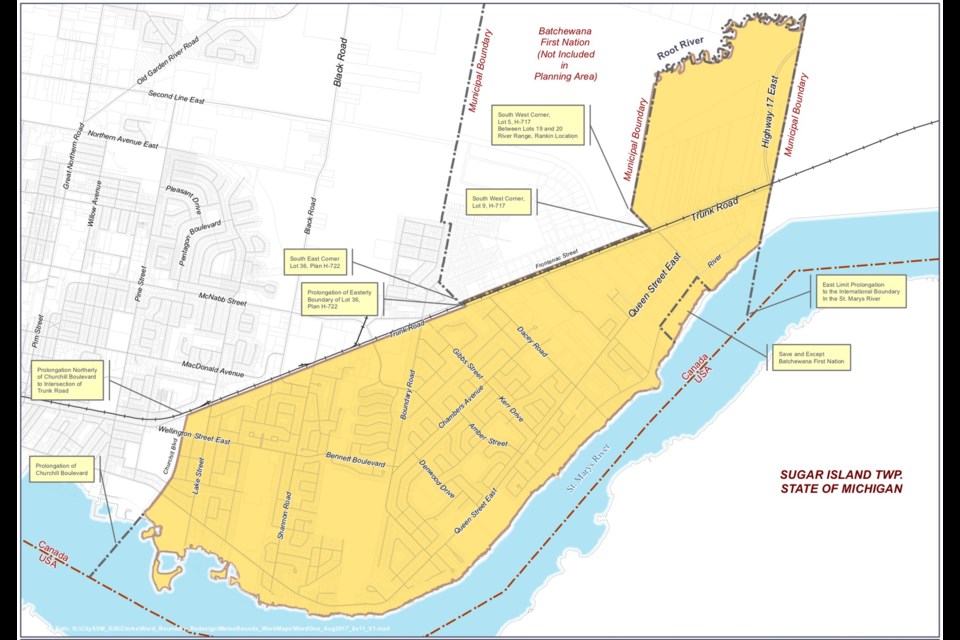Sault Ste. Marie City Council will be asked tonight to approve boundaries for the new five-ward, 10-councillor electoral system..
The final boundary recommendations were developed by city staff after public open houses on Jul. 26 and Aug. 2.
Deputy chief administrative officer Malcolm White says a variance of up to 25 per cent of the mean ward population of 14,674 is considered acceptable when weighed against other principles of effective representation.
Here are the populations for each new ward, with percentage of mean population shown in brackets:
-
Ward 1 - 17,886 (115 per cent)
-
Ward 2 - 15,666 (107 per cent)
-
Ward 3 - 14,507 (99 per cent)
-
Ward 4 - 14,425 (98 per cent)
-
Ward 5 - 11,884 (81 per cent)
White says two boundary revisions were made after the public consultations:
"The first revision concerns a small residential pocket on the south side of Wallace Terrace (Bloor Street West, Patrick Street, Adelaide Street, Carleton Avenue and Sherbourne Street). The boundary has been revised so that this residential area is added to the residential component on the north side of Wallace Terrace. The new boundary is similar to the existing boundary between the current Wards 5 and 6."
"The second revision concerns the residential neighbourhood area at the top of Bruce Hill. The boundary between Wards 2 and 4 has been revised to keep this."
White adds that two other suggestions for revision were received and considered:
"One suggestion was to change the division line between Wards 4 and 5 to a prolongation of Goulais Avenue. This suggestion was problematic in that it would bisect a census tract. As well, the proposed boundary of Old Goulais Bay Road is an existing physical delineation and the boundary between the former Townships of Korah and Tarentorus."
"Another suggestion to significantly alter the proposed boundaries was investigated; however, the changes created new communities of interest, and while evening population, in the opinion of staff, did not adequately balance all of the principles of effective representation."
Here's how White described the principles of effective representation in a report to City Council last month:
The principle of effective representation was set out by the Supreme Court of Canada in Reference Re Provincial Electoral Boundaries (Saskatchewan), [1991] 2 S.C.R. 158 (Carter), the leading authority for evaluating electoral systems in Canada.
The issue in Carter was whether a difference in population between provincial ridings in Saskatchewan infringed the right to vote protected by Section 3 of the Canadian Charter of Rights and Freedoms.
In Carter, the Supreme Court held that the purpose of the right to vote enshrined in the charter is not “equality of voting power” but the right to “effective representation.”
Effective representative is the right to be “represented in government,” where “representation” entails both the right to a voice in the deliberations of government (the legislative role of elected representatives) and the right to bring your concerns to your representative (the ombudsman role of elected representatives).
Effective representation begins with voter parity, the idea that all votes should have equal weight and, as a result, the number of people living in each ward should be similar.
According to the Supreme Court: “A system which dilutes one citizen's vote unduly as compared with another citizen's vote runs the risk of providing inadequate representation to the citizen whose vote is diluted. The legislative power of the citizen whose vote is diluted will be reduced, as may be access to and assistance from his or her representative. The result will be uneven and unfair representation.”
The Supreme Court held that while parity is of “prime importance” it is “not the only factor to be taken into account in ensuring effective representation.”
Notwithstanding the fact that the value of a citizen's vote should not be unduly diluted, effective representation often cannot be achieved without taking other factors into consideration in achieving a balance.
Monday's City Council meeting will be livestreamed on SooToday.com.
